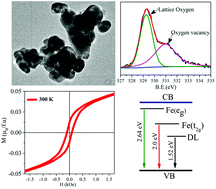Oxygen vacancy mediated room-temperature ferromagnetism and band gap narrowing in DyFe0.5Cr0.5O3 nanoparticles†
Abstract
We report on the magnetic and optical properties of DyFe0.5Cr0.5O3 nanoparticles synthesized by a sol–gel method. Rietveld refinement of a powder X-ray diffraction (XRD) pattern confirms the formation of an orthorhombic disordered phase with the Pnma space group. The formation of nano-sized particles, with an average size of 42(±12) nm, was approximated by the transmission electron microscopy (TEM) image analysis. X-ray photoelectron spectroscopy (XPS) of this compound reveals the presence of Fe2+/Fe3+ and Cr2+/Cr3+ mixed-valence states as a consequence of oxygen vacancies present at the surface of nanoparticles. The temperature-dependent magnetization (M–T) shows a finite non-zero magnetization up to 300 K and the field-dependent magnetization (M–H) curve exhibits a weak ferromagnetic (WFM) nature at 300 K with a clear hysteresis loop, which is quite appealing compared to that of the previously reported micron-sized DyFe0.5Cr0.5O3. These observations indicate that the large concentration of uncompensated surface spin of nanoparticles could be responsible for the observed room-temperature ferromagnetism. Moreover, DyFe0.5Cr0.5O3 nanoparticles show a significantly narrow band gap (Eg ∼ 2.0 eV). Meanwhile, the oxygen vacancies may generate shallow trap energy levels within the band gap as observed from photoluminescence (PL) spectroscopy. The observed band gap narrowing by Fe doping and the effect of oxygen vacancies on the band gap are consistent with the predictions of density functional theory (DFT) calculations. The evidence of room-temperature ferromagnetism in DyFe0.5Cr0.5O3 nanoparticles compared to their bulk counterparts and the significantly narrow band gap in the visible range manifest the potential of this material in spintronic and optical applications.



 Please wait while we load your content...
Please wait while we load your content...